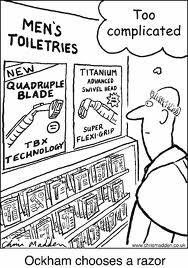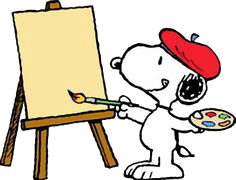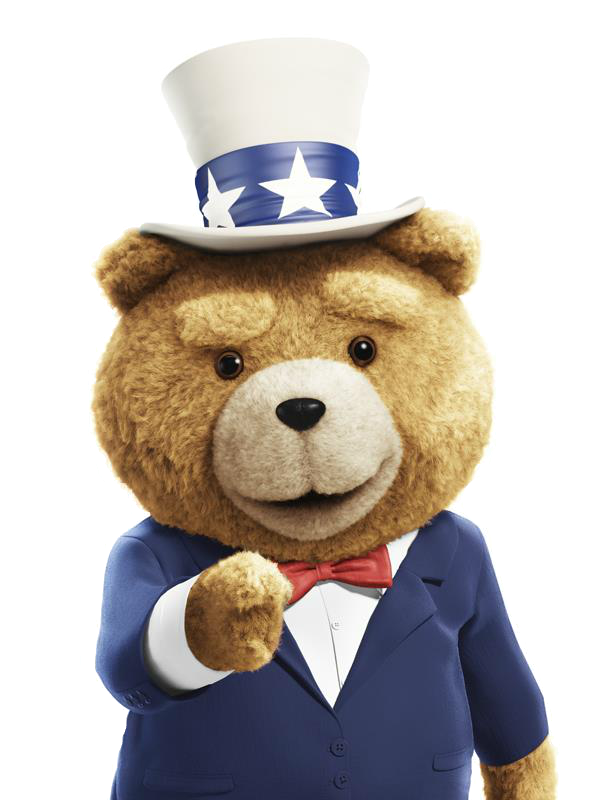Welcome to the Tables and Figures class webpage. The purpose of this course is, of course, to enhance your knowledge of and ability to effecetively use both tables and figures in your policy paper and any future academic writing you undertake. Our anchor in the storm is the APA, which naturally has lots of guidelines on these things.
On this page you'll find links to the various files we'll be using inside and outside of class.
A scheduling note: As you can see, this is basically a 4-week, intensive course because I have previous engagements in March.
Class 1 (Tuesday, February 7, 2017) — Class introduction and Occam the Barber
 An interesting read about Occam's Razor titled
The Razor in the Toolbox
(or here as a pdf)
An interesting read about Occam's Razor titled
The Razor in the Toolbox
(or here as a pdf)
I will be posting class notes each week for your reading pleasure. Here, good people, is the first
installment, cleverly labeled as Class Notes #1. (You
might also find last year's Class Notes #1 (2015) to be
useful.)
As you recall from class, we looked at some
examples of different types of tables.
You will also remember that we looked at some
examples from my dissertation.
Here is the very simple example about our friend, the
decimal tab.
Homework:
- ✓Bring a table or figure to present in class
next week.
Class 2 (Friday, February 10, 2017) — Nuts & Bolts of Tables
Good evening, everyone. Our purpose today is to talk a bit more about tables and then move ahead to figures. However, before doing so I would like to point you to a link that shows the parts of an APA table.
We'll be looking at the class notes #2 file, and herein you'll find several very, very handy keyboard shortcuts.
Homework:
Class 3 (Tuesday, February 14, 2017)
Good evening, everyone. Tonight we will be working more with tables ...
After class this evening I will post the class notes from today's class, which you'll cleverly find
labeled as
Class Notes #3.
Here, too, is the example I mentioned at the end of class tonight of how a table could be rotated to more effectively present the data.
Homework:
- ✓Wainer (1992)
- ✓ Elwood & Monoi (2015), Measuring Carefully
Class 4 (Friday, February 17, 2017)
Good evening, everyone. Our purpose today is to talk a bit more about tables and then move ahead to figures. However, before doing so I would like to point you to a link that shows the parts of an APA table.
Next, let's play consumer for a bit. I'd like to look at the tables and figures in two articles, one by Myford and Wolfe (2004) and the second by a colleague and myself. The actual content is of little importance at this point, but I would like each of you to examine several tables and figures and then do several things with each:
- ✓introduce the table or figure,
- ✓find where in the text it is referenced,
- ✓evaluate the title (for the table) or the caption (for the figure)
- ✓evaluate the table or figure format (correct?)
- ✓evaluate the note(s), and
- ✓comment on how the table or figure could be improved.
Here we go with figures. Below I've included some links and resources for creating figures using Excel, which is probably where most of your data will reside. Let's begin with a look at Excel and some of the various functions for creating figures; here is the Excel file from which I'll be working this evening.
In addition, let's take a look at a most informative webpage on creating an Excel graph, courtesy of the fine people at Wikihow.
Homework & Class Material:
- ✓ Wikihow: Creating an Excel graph (webpage) | WikiHow data set
- ✓ Creating figures in Excel (Word)
- ✓ Using Excel to create figures (Word) | Using Excel data set
- ✓ How to create powerful graphs and charts in Excel, courtesy of Gavin Phillips
- ✓ Make your charts look better, courtesy of Anna Cushing at SEER Interactive
- ✓HW: Bring two figures to our next class. If possible, bring two different kinds of figures.
Class 5 (Tuesday, February 21, 2017) —
We'll begin this evening with a look at the figures you kindly provided for our class. Please pair up and critique each other's figures.
Our second task this evening is take a quick dip into the world of corpus analysis of written text. For those who have participated in our various vocabulary classes or workshops, you'll know that searching a large body ("corpus") of data for patterns and examples can be a very informative exercise. To examine what verbs generally occur (collocate) with the words table and figure, I utilized our very own Corpus of Published Works and found these interesting results. Of course, feel free to download this file and scrutinize it at length when you have time.
Here is the useful phrases handout from our last class.
 A (profound?) thought: Making an effective figure is often like creating a fine
painting. As we embark on our journey into the world of figures, allow me to unapologetically provide the
list from our friends at the APA about what constitutes a good figure
(APA Manual, 6th ed., pp. 152-153). To wit, a good figure ...
A (profound?) thought: Making an effective figure is often like creating a fine
painting. As we embark on our journey into the world of figures, allow me to unapologetically provide the
list from our friends at the APA about what constitutes a good figure
(APA Manual, 6th ed., pp. 152-153). To wit, a good figure ...
- ✓augments rather than duplicates the text,
- ✓conveys only essential facts,
- ✓omits visually distracting detail,
- ✓is easy to read—its elements (type, lines, labels, symbols, etc.) are large enough to be read with ease,
- ✓is easy to understand—its purpose is readily apparent,
- ✓is consistent with and in the same style as similar figures in the same article, and
- ✓is carefully planned and prepared.
Moreover, be certain in figures of all types that ...
- ✓lines are smooth and sharp,
- ✓typeface is simple (i.e., sans serif) and legible,
- ✓units of measure are provided,
- ✓axes are clearly labeled, and
- ✓elements within the figure are labeled or explained.
Here, Good Folks, are some files for use this evening.
Class 6 (Friday, February 24, 2017) —
Good evening, everyone, and I hope the long 22 hours since the end of our last class have treated you well! Tonight I'd like to begin with a look at the figures from my dissertation, which most of you received yesterday evening.
I was recently reviewing a paper for a journal, which I believe I mentioned at some point. This involves evaluating many things, of course, among which I always provide feedback on tables and figures. In this particular case, I suggested that the author(s) could improve a figure, to which the author replied, "Oh, this is the output from the program, so it's fine." No, it was certainly NOT fine—you are the author, and you decide how to present your material.
At any rate, let me provide you with the original figure as well as my solution for your enjoyment: a simple Word document with some shapes on it, which I call my figure workbench. The idea, of course, is for you to use this figure workbench to construct better figures.
More for reference than anything else, here is the section on
Displaying figures from the APA manual (6th ed.)
Homework:
- ✓Revise the original figure located at the link above. This assignment should be submitted in about a week, but that deadline is very flexible.
Class 7 (Monday, March 6, 2017) —
Thanks for coming on this Friday evening, everyone.
This evening, I'd like to split our class in half (or thereabouts). One part will be to reproduce this fine figure from a dissertation some time ago, or you may build a figure using three types of data from this handy webpage about those friendly folks just north of my home state of Montana.
 The second part of our class, should be have time for it, would be to peruse and comment
on some of the following articles.
The second part of our class, should be have time for it, would be to peruse and comment
on some of the following articles.
- ✓Displaying figures from the APA manual (6th ed.)
- ✓Cultural influences
- ✓Feedback recall
- ✓Latent growth curve
- ✓Visual experiences
- ✓Tomas & Oliver (1999)
- ✓Bitchener (2008)
- ✓Class notes #6
Class 8 (Friday, March 17, 2017) —
Today we'll be looking at a couple of webpages with many figures (and tables). Please note, however, that these various tables are NOT in APA format although they are similar. My purpose in looking at them is to point out a number of things to keep in mind. Thus, with no further ado, let's peruse a useful webpage courtesy of the Department of Biology at Bates College in Lewiston, Maine.
Another very helpful source (Rolandi, Cheng, & Perez-Kriz, 2011) deals with designing effective papers. Should you so desire, here is the actual document as a PDF.
Back by popular demand, here are the class notes from today's class.
Final Exam (take-home)
Here, good folks, is your final exam. As you can see, it consists of three tasks, which will be handed in by email by April 3, 2017 (Monday). You may use any resouces you'd like to help you (e.g., class notes). However, you may not discuss the test with your classmates.
Examples from the APA Manual (6th edition)
As you can likely guess, in this section you'll find pdf files that include table examples, both the original table and a modified version (figures, too). The idea is that as you work on your policy papers, you perhaps will need to modify and present tables and figures in your manuscript.
- ✓ Factor analysis table from Tackett, Silberschmidt, Krueger, and Sponheim (2008)
- ✓ Summary of correlations from Walker, Wingate, Obasi, and Joiner (2008)
- ✓ Estimates and 95% Confidence Interals table from Stahl and Klauer (2008)
- ✓ Weight-related variables table from Crow, Eisenberg, Story, and Neumark-Sztainer (2008)
- ✓ Psychometric properties of Major Study Variables table from from Major, Zubek, Cooper, Cozzarelli, and Richards (1997)
- ✓ Contrast of Time 1 With Time 2 table from Maslach and Leiter (2008)
- ✓ Regression Results table from Reynolds (2008)
